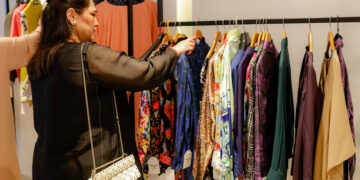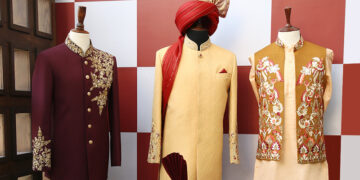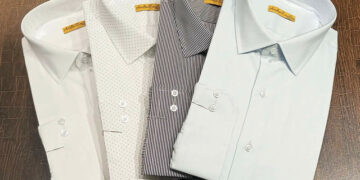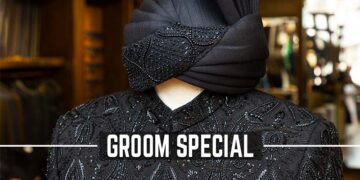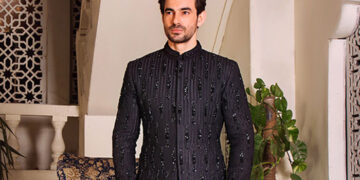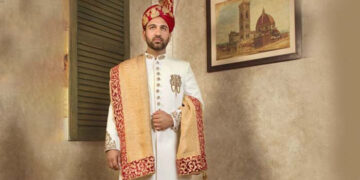 NEW YORK – Marc Jacobs is the guy who can change the direction of a fashion juggernaut with a single silhouette. If other designers are doing sleek and slim, he’ll do big and poufy. If everyone else is doing neutral colors, he’ll go bold.
NEW YORK – Marc Jacobs is the guy who can change the direction of a fashion juggernaut with a single silhouette. If other designers are doing sleek and slim, he’ll do big and poufy. If everyone else is doing neutral colors, he’ll go bold.
There have been the grunge collections, the granny collections, harem pants, punk prom dresses and ultra-chic skirt suits. If they seem out of step with trends seen elsewhere on runways during a particular season, the others come around in the weeks and months that follow, just when Jacobs is ready to move on again.
Yet, while he swaps out the details in rapid fire, there is almost unparalleled consistency, too: He likes surprises, takes risks, embraces showmanship, pairs patterns and textures, finds balance between artistry and commercialism, and sees the importance in a visual statement.
He keeps the jaded industry on its toes — sometimes with a little arrogance. But editors, stylists, retailers and celebrities seem to stay firmly supportive of Jacobs with constant toasts to his talent.
One of the biggest lovefests will come Monday at the annual Council of Fashion Designers of America awards, a splashy ceremony at Lincoln Center to be hosted by Anderson Cooper with Lady Gaga receiving one of the prizes. Jacobs has been selected as the lifetime achievement winner, a title previously won by Michael Kors, Diane von Furstenberg, Donna Karan, Yves Saint Laurent and Geoffrey Beene, for whom the award is now named.
Jacobs, who already has won numerous times in the competitive categories of womenswear, menswear and accessories, could go home double-fisted: He is nominated as the year’s best women’s designer again, this time facing Alexander Wang and the design duo Lazaro Hernandez and Jack McCollough of Proenza Schouler.
Wang and Proenza Schouler are the new hipster guard, but they’re not considered as influential or directional as Jacobs, who, at 48, isn’t ready pass the torch.
“It’s crazy,” says Jacobs. “I mean, I have a lot more to do. `Achievement’ sounds final. I’d like to call it `Lifetime of achievement — and for what’s left to achieve.'”
He adds, “I have no intention of slowing down. I don’t rest anyway.”
Jacobs doesn’t have the jet-setter image that some of his peers do. Photos don’t surface of his long holidays in the Caribbean or treks in exotic places, and he’s not a staple of the red carpet or the charity circuit. One thinks of Jacobs as the quirky downtown guy, even if he’s at the forefront of two mega brands — his namesake collection, plus Louis Vuitton and all the subsidiaries that go with it, including the contemporary-priced Marc by Marc Jacobs line, swimwear, sunglasses, shoes and handbags.
He sleeps with Post-It notes and a pen at his bedside to jot down the barrage of thoughts, inspirations and reminders that come between what are essentially naps, but organized with lists and schedules he is not, Jacobs says with a laugh.
He’s also an avid consumer of art and culture, including music, movies and contemporary paintings and sculpture. Interiors are a passion at the moment, and he has started to collect Art Deco furniture. The most peaceful points of his day are mornings at the gym and evening walks with his two English bull terriers. Alas, while he splits his time between New York and Paris, the dogs live in France, so he doesn’t always get his down time with them.
“As soon as the New York shows are over, I’m on a plane after the Marc show. I take one day to recover, then I take in at Louis Vuitton things I’ve only seen by the Internet. I’m overwhelmed by all the stuff that progresses and there’s a constant series of fittings, corrections, additions,” he explains during a recent telephone interview. “The next show is always the most important thing.”
Jacobs’ Fashion Week shows are musts not only for those making the buying and editorial decisions from the front row, but they consistently are the most viewed and buzzed about online by shoppers and fans. The designer pays attention to what everyone is saying.
“I read what people say. It affects me greatly. That’s what is the biggest pressure: I feel like we’re competing with ourselves each time,” Jacobs says. “I always feel each season is the strongest show we’ve had, and I guess every time the new season begins, I go through all the stress and anxiety of what we are going to do next. It’s always time to start over.”
All the newness, however, isn’t completely free of baggage from the past, including diva moments, a party-hard attitude and stints in rehab. And then there are the fashion upstarts trying to mimic his meteoric rise and become the new bellwether.
The native New Yorker’s strong sense of style emerged when he was a teen, attending the High School of Art and Design and being named by Parsons the New School for Design as its student of the year. He launched his label in 1986 and became the youngest winner of an emerging talent award from the CFDA.
He was hired — along with business partner Robert Duffy, who has been with Jacobs since — at Perry Ellis in 1989 to revive a brand that lost its way with Ellis’ death a few years earlier. Jacobs put Perry Ellis back on the map, for sure, but company executives weren’t as charmed by his flannel shirts and plaid prints in the landmark 1992 grunge collection. He and Duffy were fired not long after.
They launched a new version of their company in 1993, but it didn’t have an immediate impact. It chugged along until Jacobs started moonlighting for Louis Vuitton, which also brought financial backing from powerhouse parent company LVMH.
He became the wunderkind yet again.
Jacobs has the unusual ability to connect to the woman who is going to wear his clothes, says Bridget Foley, executive editor of Women’s Wear Daily. He is passionate about style, she says, but doesn’t make it more than it is, either. “Marc doesn’t over-intellectualize clothes. He loves it because of fashion. He loves beautiful things, but he’s not an over-analyzer of the process or result.”
It’s not a matter of the accolades, money or even attention, all of which he readily admits he loves — especially the attention, Jacobs says. It’s about a paying customer making a choice. “That’s how I define success: Seeing someone in something I’ve had a hand in designing. It could be shoes, a bag, a dress. If we’re lucky enough that someone has chosen ours, I’m so grateful and I’m always struck by it.”
He doesn’t narrow the description of his muse or even his target consumer to cool types such as his friends Sofia Coppola, Victoria Beckham or Kim Gordon; that would be too limiting. He’d rather think his shopper has “a very full life that’s rich with things they don’t need and want to make life more beautiful.”
Jacobs is true to himself and that vision, and that contributes to his longevity, Foley adds. “He’s at the peak of influence and clout. He’s maintaining the excitement. Marc is one of the most anticipated shows of the season anywhere, and that’s hard to maintain over the long haul. Miuccia Prada has the same thing. … You don’t know what to expect — he could do A for spring and C for fall, yet each is consummately Marc Jacobs.”
What to do next is always on Jacobs’ mind. “I’m not a linear thinker, nothing ever comes from one source,” he says. The inspiration “can come from anywhere and come anytime,” although he’s never starting from scratch, nor is he ever really done. It’s all an evolution, with his famous last-minute tinkering to get layers to sit just so or the perfect color lipstick on the it-girl model that no one knows is the next it girl until she appears on Jacobs’ catwalk.
Jacobs says he is friendly with other industry insiders and is a cheerleader for them. He is in the unique position to appreciate their accomplishments, he notes. “When I see reports that another show is great, or I can see it — even on the Internet — as a great work, I feel good. I know what it takes to do this job: the stress, the trial and error, the dedication.”
The payoff is undeniable, though. “I’m first and foremost a fashion fan — it’s my original reason for doing this, and it’s still my reason for doing this.”



